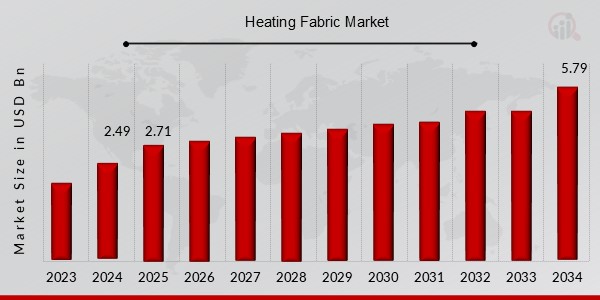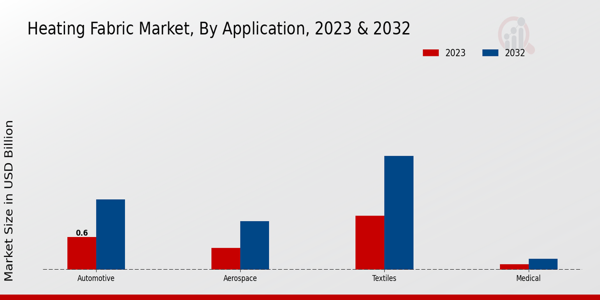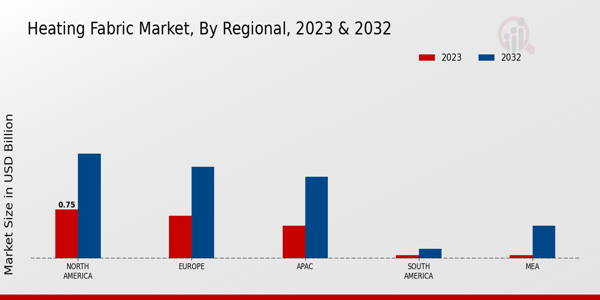Global Heating Fabric Market Overview
The Heating Fabric Market Size was estimated at 2.49 (USD Billion) in 2024. Heating Fabric Industry is expected to grow from 2.71 (USD Billion) in 2025 to 5.79 (USD Billion) by 2034, at a CAGR (growth rate) is expected to be around 8.80% during the forecast period (2025 - 2034)
Key Heating Fabric Market Trends Highlighted
Several factors enable us to appreciate the situation regarding the currently growing Heating Fabric Market. On the one hand the purchasing power of people has increased and there is a constant change in the economy and its trends leading to consumers shifting towards integrated heating solutions which are cost efficient. On the other hand, improvement in technology has led to development of light weight and flexible heating fabrics which in turn has increased the demand for heating solutions as they have become more convenient to use. Additionally, it is observed that there is growing emphasis on eco-friendly practices leading manufacturers to be more innovative in product development.
The market has plenty of possibilities when it comes to opportunities. The demand for smart home automation has also increased in the last couple of years which means that there is a demand for fabrics that can be embedded into smart home systems. The electrical or thermal fabrics can make it attractive to consumers and ease their daily tasks. Furthermore, there are many other industries where the fabrics can be applied such as automotive or healthcare. In the future heat fabrics will appeal to various industries as they provide versatility and new segments within the active market.
A clear shift towards personalization and customizing heating needs is becoming apparent. It is not only the basic functions of the products consumers are after, but also the comfort and visual values. More and more, heating fabrics equipped with smart functions, such as remote controls or integration into smart homes, are included in the systems. In addition, already now joint ventures between fabric and IT industries appear, which accelerate the development of heating textiles. The changing preferences of consumers will push the market to newer alternatives, which are innovative yet elegant, thus making heating fabrics an essential part of the fabric of the surroundings.

Source: Primary Research, Secondary Research, MRFR Database and Analyst Review
Heating Fabric Market Drivers
Growing Demand for Smart Textiles
The Heating Fabric Market Industry is experiencing significant growth driven by the increasing demand for smart textiles. As technology advances, consumers are becoming more interested in multifunctional materials that enhance their daily lives. Heating fabrics are at the forefront of this trend, offering not just warmth but also the potential for integration with smart home systems and wearable technology. These fabrics can be embedded with sensors and connectivity features that allow users to monitor their body temperature, control warmth levels, and even interact with other smart devices.This growing trend toward integrated technology in textiles aligns with consumer preferences for convenience and personalized experiences. With advancements in nanotechnology and materials science, manufacturers are developing heating fabrics that are lighter, more efficient, and more comfortable to wear, meeting the diverse needs of consumers in various applications. As a result, the market for heating fabrics is expected to expand significantly in the coming years, propelled by the demand for innovative, high-tech solutions in both fashion and functionality.
Increased Adoption in Healthcare Applications
The Heating Fabric Market Industry is witnessing a surge in the adoption of heating fabrics in healthcare applications, particularly for patient care and rehabilitation. Heating fabrics are being utilized in medical garments and therapeutic devices that provide warmth and comfort to patients, aiding in recovery from injuries and surgeries. These fabrics help alleviate pain and improve blood circulation, making them invaluable in hospitals and home care settings.As healthcare providers seek enhanced solutions for patient management, the demand for effective and comfortable heating options continues to grow, driving innovation and investment in the Heating Fabric Market.
Rising Consumer Awareness of Comfort and Wellness
In recent years, there has been a marked increase in consumer awareness regarding comfort and wellness, significantly influencing the Heating Fabric Market Industry. As lifestyles change and the focus on well-being becomes more pronounced, consumers are seeking products that enhance their quality of life, especially during colder weather. Heating fabrics provide an innovative solution to thermal comfort, ensuring warmth and coziness in everyday settings.This heightened demand is leading manufacturers to invest more in R, creating advanced heating fabric solutions that promote not only comfort but also health benefits. The trend towards wellness, combined with the growing outdoor lifestyle, is propelling the adoption of heating fabrics across various sectors, including sportswear and leisure clothing.
Heating Fabric Market Segment Insights
Heating Fabric Market Application Insights
The Heating Fabric Market encompasses a variety of applications that showcase its versatility and utility across different sectors. In 2023, this market is valued at 2.1 billion USD, reflecting the growing recognition and adoption of heating fabric technology. The Automotive segment holds significant prominence with a valuation of 0.6 billion USD, which is projected to increase to 1.3 billion USD by 2032, demonstrating its potential as vehicles become more advanced in terms of comfort and efficiency. Automotive heating fabrics are increasingly integrated into seats and upholstery, enhancing passenger comfort during colder months and promoting energy efficiency in automotive design. The Aerospace industry, while smaller, also plays a crucial role, starting from a valuation of 0.4 billion USD in 2023 and expected to reach 0.9 billion USD by 2032; the application of heating fabrics in this sector helps improve passenger experience and safety on board by ensuring consistent temperature control in various environments.The Textiles application leads in market valuation with 1.0 billion USD in 2023, anticipated to double to 2.1 billion USD by 2032, showcasing the significant demand for heated clothing, blankets, and other textile-based heating solutions that are gaining traction among consumers looking for personal comfort. This segment dominates due to the everyday applicability of heating functionalities in a wide range of textile products, combined with innovative designs that cater to consumer preferences. Lastly, the Medical segment, although the smallest with a valuation of 0.1 billion USD in 2023 and projected to reach 0.2 billion USD by 2032, is nevertheless important, as heating fabrics find utilization in therapeutic applications for pain relief and recovery, indicating a growing trend towards the incorporation of advanced materials in health and wellness. Overall, the segmentation of the Heating Fabric Market highlights the multifaceted nature of heating fabrics across various applications, driven by technological advancements, consumer demand for comfort, and a growing emphasis on energy efficiency. The market growth is supported by trends such as personalization in textiles and the increasing need for smart materials in automotive and aerospace sectors, representing both opportunities and challenges for stakeholders involved.

Source: Primary Research, Secondary Research, MRFR Database and Analyst Review
Heating Fabric Market Product Type Insights
The Heating Fabric Market is projected to hold a valuation of 2.1 billion USD in 2023 and is expected to grow significantly by 2032. Within the Product Type segment, several categories play a crucial role in the overall market performance, with Heating Pads, Heating Blankets, Heating Clothing, and Heating Mats being key components. Heating Pads have gained traction due to their ability to provide targeted relief for muscle pain, making them a preferred choice for consumers. Meanwhile, Heating Blankets are increasingly popular for their comfort and widespread application in home settings, appealing to a diverse consumer base.Heating Clothing, designed for outdoor activities, offers warmth and convenience for individuals facing cold weather, enhancing the market's broader appeal. Heating Mats also cater to specific needs, particularly in wellness and therapeutic environments. This diverse array of products contributes to the Heating Fabric Market revenue growth, driven by rising awareness of health benefits, demand for innovative heating solutions, and advancements in fabric technology. The market is characterized by dynamic trends, innovative product offerings, and a growing emphasis on energy-efficient solutions, all influencing the overall Heating Fabric Market statistics and segmentation.
Heating Fabric Market Material Insights
The Heating Fabric Market, valued at 2.1 USD Billion in 2023, showcases significant expansion potential, particularly within the Material segment. The driving factors behind this growth include the rising demand for advanced textile solutions across various industries such as automotive, healthcare, and home textiles. The market segmentation highlights key materials like Polyester, Nylon, Cotton, and Conductive Polymers, each playing a crucial role in enhancing the functionality of heating fabrics. Polyester, known for its durability and moisture-wicking properties, is particularly favored in applications where strength and weight are critical, thus holding a substantial share of the market.Nylon offers excellent elasticity, making it suitable for areas requiring flexibility and comfort. Cotton, with its natural fibers, appeals to consumers seeking breathable and eco-friendly options, presenting considerable opportunities in the market. Conductive Polymers are rapidly gaining traction due to their ability to integrate electronic functionalities into fabrics, positioning them as a significant innovation driver within the market. Overall, the Heating Fabric Market statistics illustrate a dynamic landscape characterized by diverse material compositions, contributing to diverse product applications and driving market growth.
Heating Fabric Market End Use Insights
The Heating Fabric Market is experiencing significant growth across various end-use applications, with the market expected to be valued at approximately 2.1 USD billion in 2023. This growth is largely driven by the rising demand for energy-efficient solutions in both residential and commercial spaces, as well as in the industrial sector. In residential applications, heating fabrics offer not only comfort but also energy savings, making them a preferred choice among homeowners. The commercial sector, which encompasses offices, retail, and hospitality, is recognizing the importance of heating fabrics for enhancing customer experience and reducing energy costs.Furthermore, the industrial segment plays a crucial role, particularly in processes requiring temperature control; thus, it significantly influences the Heating Fabric Market revenue. As this market expands, trends such as increased energy efficiency, growing awareness of sustainable practices, and advancements in fabric technology are shaping the Competitive landscape. However, challenges such as high initial investment costs and competition from alternative heating solutions persist. Overall, the Heating Fabric Market segmentation highlights the diverse applications and the increasing relevance of heating fabrics across various sectors, ultimately contributing to the market's robust growth trajectory.
Heating Fabric Market Regional Insights
The Heating Fabric Market is segmented regionally into North America, Europe, APAC, South America, and MEA. North America dominated this market with a valuation of 0.75 USD Billion in 2023 and is projected to grow to 1.6 USD Billion by 2032. This significant growth reflects the region's early adoption of advanced textile technologies and increasing applications in various industries. Europe follows closely, being valued at 0.65 USD Billion in 2023, expected to reach 1.4 USD Billion by 2032, as it emphasizes sustainable heating solutions. APAC, with a valuation of 0.5 USD Billion in 2023 and projected to reach 1.25 USD Billion in 2032, is significant due to its rapid industrialization and growing consumer demand for heating fabrics in textile applications.South America and MEA, though currently valued at 0.05 USD Billion each in 2023, show potential for growth, particularly with increasing awareness and adoption of heating technologies. The data indicates a strong inclination toward market growth across all regions, driven by technological advancements and a rising trend towards energy efficiency in textiles.

Source: Primary Research, Secondary Research, MRFR Database and Analyst Review
Heating Fabric Market Key Players and Competitive Insights
The Heating Fabric Market is experiencing significant growth driven by increasing demand for energy-efficient solutions and advancements in fabric technology. As the market evolves, various players are entering the arena, competing through innovation, product quality, and customer engagement. Competitive insights reveal that key manufacturers focus on research and development to create advanced heating solutions that cater to a wide range of applications, including automotive, aerospace, and industrial sectors. The competitive landscape is characterized by strategic partnerships and collaborations aimed at enhancing product capabilities, effectively responding to emerging market trends, and ensuring sustainability in manufacturing processes. Companies are striving to differentiate their offerings through unmatched performance, durability, and user-friendly features, ultimately shaping the future of the heating fabric sector.Parker Hannifin stands out in the Heating Fabric Market due to its robust reputation for innovation and quality. Renowned for its engineering prowess, Parker Hannifin has established a strong foothold by leveraging cutting-edge technology that integrates seamlessly into heating fabric applications. The company's extensive product portfolio includes custom heating solutions that cater to a variety of industries, showcasing versatility and adaptability. Parker Hannifin emphasizes research and development to continually enhance product performance while adhering to strict safety and regulatory standards. The company’s commitment to sustainability and eco-friendly manufacturing processes also positions it favorably within the competitive landscape, appealing to environmentally-conscious consumers and industries alike.Noble Biomaterials presents a unique approach within the Heating Fabric Market by focusing on innovative antibacterial and conductivity-enhancing properties of its fabrics. Known for its advanced textile technologies, Noble Biomaterials has carved a niche for itself, enhancing the performance and functionality of heating fabrics across different applications. The company’s emphasis on innovative solutions not only provides added value to consumers but also meets the growing demand for smart textiles within the industry. With a strong commitment to sustainability, Noble Biomaterials has successfully integrated eco-friendly practices into its operations, which resonates well with modern market expectations. Their continuous investment in research and development ensures that they remain at the forefront of technology trends, strengthening their market position against competitors and fostering growth in the heating fabric sector.
Key Companies in the Heating Fabric Market Include
- Parker Hannifin
- Noble Biomaterials
- CeramTec
- ThermoFisher Scientific
- 3M
- SaintGobain
- DuPont
- BASF
- Lhotse
- Hexagon Manufacturing Intelligence
- Mubadala Investment Company
- Smith’s Group
- Owens Corning
- Tentnology
Heating Fabric Market Industry Developments
Recent developments in the Heating Fabric Market have shown significant innovations and strategic movements among key players. Companies like Parker Hannifin and 3M are increasingly focusing on advanced heating fabric technologies, emphasizing applications in automotive and aerospace sectors. Additionally, Noble Biomaterials has been pioneering the integration of antimicrobial properties into heating fabrics, catering to growing health and hygiene concerns. The market has also observed consolidation activities, with notable mergers and acquisitions; for instance, CeramTec has acquired a competitor to enhance its thermal management capabilities. Such strategic alignments are indicative of an effort to diversify product offerings and improve market penetration. Furthermore, DuPont and BASF have reported advancements in sustainable heating materials, aligning with global sustainability trends. Hexagon Manufacturing Intelligence's investments in smart fabrics technology are anticipated to lead to enhanced performance metrics. The overall market valuation is witnessing substantial growth, driven by increasing demand for energy-efficient solutions and the expansion of applications across various industries, offering a positive outlook for companies like Saint-Gobain and Owens Corning in the heating fabric sector.
Heating Fabric Market Segmentation Insights
-
Heating Fabric Market Application Outlook
- Automotive
- Aerospace
- Textiles
- Medical
-
Heating Fabric Market Product Type Outlook
- Heating Pads
- Heating Blankets
- Heating Clothing
- Heating Mats
-
Heating Fabric Market Material Outlook
- Polyester
- Nylon
- Cotton
- Conductive Polymers
-
Heating Fabric Market End Use Outlook
- Residential
- Commercial
- Industrial
-
Heating Fabric Market Regional Outlook
- North America
- Europe
- South America
- Asia Pacific
- Middle East and Africa
|
Report Attribute/Metric
|
Details
|
|
Market Size 2024
|
2.49 (USD Billion)
|
|
Market Size 2025
|
2.71 (USD Billion)
|
|
Market Size 2034
|
5.79 (USD Billion)
|
|
Compound Annual Growth Rate (CAGR)
|
8.80% (2025 - 2034)
|
|
Report Coverage
|
Revenue Forecast, Competitive Landscape, Growth Factors, and Trends
|
|
Base Year
|
2024
|
|
Market Forecast Period
|
2025 - 2034
|
|
Historical Data
|
2020 - 2024
|
| Market Forecast Units |
USD Billion |
| Key Companies Profiled |
Parker Hannifin, Noble Biomaterials, CeramTec, ThermoFisher Scientific, 3M, SaintGobain, DuPont, BASF, Lhotse, Hexagon Manufacturing Intelligence, Mubadala Investment Company, Smiths Group, Owens Corning, Tentnology |
| Segments Covered |
Application, Product Type, Material, End Use, Regional |
| Key Market Opportunities |
Rising demand in smart textiles, Expansion in automotive applications, Growth in medical apparel, Increased consumer awareness of comfort, Development of eco-friendly heating solutions |
| Key Market Dynamics |
Rising demand for smart textiles, Increasing applications in automotive, Growing awareness of energy efficiency, Technological advancements in heating fabrics, Expanding use in healthcare sector |
| Countries Covered |
North America, Europe, APAC, South America, MEA |
Frequently Asked Questions (FAQ) :
By 2034, the Heating Fabric Market is projected to be valued at 5.79 USD Billion.
The market is expected to grow at a CAGR of 8.80% from 2025 to 2034.
North America is anticipated to have the largest market share, valued at 1.6 USD Billion by 2032.
The Automotive application segment is projected to be valued at 1.3 USD Billion by 2032.
Key players include Parker Hannifin, Noble Biomaterials, CeramTec, and 3M, among others.
The Aerospace application segment is valued at 0.4 USD Billion in 2023.
The market in South America is valued at 0.05 USD Billion in 2023.
The Medical application segment has strong growth potential, contributing to the overall market's CAGR of 8.82% from 2024 to 2032.
The Textiles application segment is projected to reach a value of 2.1 USD Billion by 2032.
The Heating Fabric Market is valued at 0.65 USD Billion in Europe for 2023.
















